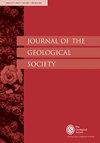Age of the basal ‘Lower Old Red Sandstone’ Stonehaven Group of Scotland: The oldest reported air-breathing land animal is Silurian (late Wenlock) in age
IF 3
3区 地球科学
Q2 GEOSCIENCES, MULTIDISCIPLINARY
引用次数: 0
Abstract
The basal upper Silurian-Lower Devonian ‘Lower Old Red Sandstone’ deposits of the Midland Valley of Scotland contain several important fossil biotas, including that from the Cowie Harbour Fish Bed. This biota is of great significance because it represents one of the oldest known examples of a fossilised terrestrial ecosystem and includes the oldest reported air-breathing land animal (the myriapod Pneumodesmus newmani Wilson & Anderson 2004). Based on biostratigraphical evidence from dispersed spores this biota is dated as late Wenlock (late Silurian) in age. Recently, however, this age constraint was challenged, based on 238 U- 296 Pb radiometric analysis of zircons, and it was proposed that these deposits are much younger (Early Devonian: Lochkovian). This proposal has serious implications regarding: (i) the composition and nature of early terrestrial ecosystems; (ii) the geological setting with respect to the timing of terrane accretion and the onset of ‘Lower Old Red Sandstone’ sedimentation. We report on newly discovered dispersed spore assemblages and additional zircon data that confirm a late Wenlock (late Silurian) age. This age designation establishes the importance of the biota of the Cowie Harbour Fish Bed and is more compatible with both its biotic composition and the regional geological setting.苏格兰斯通黑文群基底“下老红砂岩”的年龄:据报道,最古老的呼吸空气的陆地动物是志留纪(温洛克晚期)
苏格兰米德兰河谷的基础上志留统-下泥盆统“下老红砂岩”沉积物包含了几种重要的生物化石,包括来自考伊港鱼床的化石。这个生物群意义重大,因为它代表了已知最古老的陆地生态系统化石之一,包括报道的最古老的呼吸空气的陆地动物(多足动物纽马尼肺desmus newmani Wilson & &;安德森2004年)。根据分散孢子的生物地层证据,该生物群的年龄为晚文洛克(晚志留纪)。然而,根据对锆石的238 U- 296 Pb放射性分析,最近对这一年龄限制提出了挑战,并提出这些矿床要年轻得多(早泥盆世:Lochkovian)。这一建议对以下方面有严重影响:(i)早期陆地生态系统的组成和性质;(ii)有关地体增生的时间和“下古红砂岩”沉积开始的地质背景。我们报告了新发现的分散孢子组合和额外的锆石数据,证实了晚温洛克(晚志留纪)时代。这一年龄划分确立了考伊港鱼床生物群的重要性,并更符合其生物组成和区域地质环境。
本文章由计算机程序翻译,如有差异,请以英文原文为准。
求助全文
约1分钟内获得全文
求助全文
来源期刊

Journal of the Geological Society
地学-地球科学综合
CiteScore
6.00
自引率
3.70%
发文量
68
审稿时长
6-12 weeks
期刊介绍:
Journal of the Geological Society (JGS) is owned and published by the Geological Society of London.
JGS publishes topical, high-quality recent research across the full range of Earth Sciences. Papers are interdisciplinary in nature and emphasize the development of an understanding of fundamental geological processes. Broad interest articles that refer to regional studies, but which extend beyond their geographical context are also welcomed.
Each year JGS presents the ‘JGS Early Career Award'' for papers published in the journal, which rewards the writing of well-written, exciting papers from early career geologists.
The journal publishes research and invited review articles, discussion papers and thematic sets.
 求助内容:
求助内容: 应助结果提醒方式:
应助结果提醒方式:


